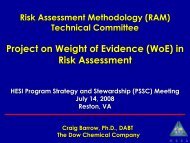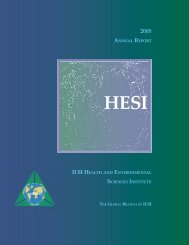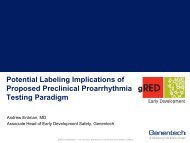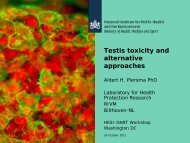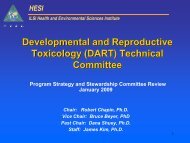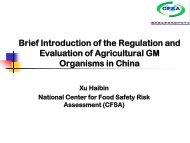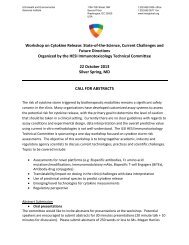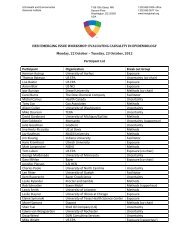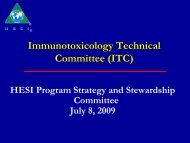Dr. Scott McClain (Syngenta, USA) - ILSI Health and Environmental ...
Dr. Scott McClain (Syngenta, USA) - ILSI Health and Environmental ...
Dr. Scott McClain (Syngenta, USA) - ILSI Health and Environmental ...
You also want an ePaper? Increase the reach of your titles
YUMPU automatically turns print PDFs into web optimized ePapers that Google loves.
<strong>ILSI</strong> <strong>Health</strong> <strong>and</strong> <strong>Environmental</strong> Sciences Institute<br />
Molecular <strong>and</strong> Protein Characterization<br />
of GMO Products<br />
Beijing, China 15-16 April 2013<br />
<strong>Scott</strong> <strong>McClain</strong>, Ph.D.<br />
<strong>Syngenta</strong> Crop Protection, LLC<br />
Research Triangle Park, NC, <strong>USA</strong>
Molecular characterization<br />
DNA<br />
Transcription<br />
mRNA<br />
Translation<br />
Protein<br />
2
Molecular characterization is a key to communicating the<br />
properties of inserted DNA in a genetically modified plant<br />
The inserted molecular component (DNA) of a transgenic crop consists of<br />
the gene(s) supporting expression of a protein(s) with specific trait(s) <strong>and</strong><br />
supporting DNA, such as promoters <strong>and</strong> terminators.<br />
T-DNA = transferred <strong>and</strong> inserted DNA that<br />
expresses one or more of the intended proteins<br />
that provide the insect resistance or other trait<br />
GOI = gene of interest<br />
3
Molecular characterization answers important questions<br />
about the inserted DNA<br />
● What DNA was put into the crop?<br />
● How many genes were put into the crop?<br />
● Where in the host genome is the inserted DNA located?<br />
● Is expression of the gene(s) stable?<br />
4
What DNA was put into host crop?<br />
● Vector Sequence – intended for insertion through the transformation<br />
process<br />
● Product (GMO Plant) Sequence Analysis – what was actually inserted<br />
into the plant<br />
Terminator<br />
Gene of interest<br />
in planta<br />
inserted<br />
DNA<br />
Transformation<br />
Vector<br />
promoter<br />
promoter<br />
Plant selectable marker<br />
Backbone – not<br />
intended for insertion<br />
Terminator<br />
5
How many genes were put into the crop?<br />
● Insert Sequence Analysis; DNA from plant is<br />
evaluated by sequencing analysis<br />
● Copy Number is evaluated by Southern<br />
Analysis<br />
6
Where was it put into the crop’s genome?<br />
Genomic Sequence Analysis<br />
Was a crop gene interrupted? – scan the genomic<br />
sequence on either side <strong>and</strong> then perform bioinformatic<br />
search to determine nearby genes, if any.<br />
At the site of insertion, were any changes made to the<br />
native genomic sequence?<br />
On what chromosome is this transgenic insert located?<br />
7
The location of the insert DNA is critical to underst<strong>and</strong>ing<br />
the location of nearby genes, if any, in the host genome<br />
8<br />
Once location of the insert DNA is confirmed,<br />
sequence of the nearby “flanking” DNA from<br />
the host plant is used to bioinformatically<br />
identify genes, if present. Sequence is<br />
compared to the genome libraries of the<br />
species of the host.
Is there potential to produce any unintended proteins?<br />
Determine if there are any sequences that could potentially result in an<br />
unintended protein. A putative fusion protein created between the insert<br />
<strong>and</strong> genomic DNA would be unintended (<strong>and</strong> unlikely).<br />
Evaluate whether sequences with stop codons on either side of genomic/insert<br />
junction are present <strong>and</strong> determine if they are significantly similar to allergens or<br />
toxins – bioinformatics is used to support this.<br />
9
Has the insert DNA been transferred to the host plant in a<br />
stable manner?<br />
Is the insert DNA still present through<br />
successive breeding generations?<br />
T 0 (starting variety)<br />
Lane 2 : Generation T3<br />
Lane 3: Generation T4<br />
Lane 4: Generation T5<br />
Lane 5: Generation T6<br />
Lane 6: Generation T7<br />
<br />
<br />
<br />
<br />
T 1<br />
T 2<br />
T 3<br />
T 4<br />
T0 = original transformant<br />
= self pollination<br />
4 th breeding<br />
generation<br />
Genetic Stability - Southern DNA<br />
Analysis<br />
T 5<br />
<br />
T 6<br />
<br />
10<br />
T 7
Additional check for molecular stability of the insert DNA<br />
Mendelian Inheritance<br />
● Does the insert inherit according to Mendel’s Law of Segregation?<br />
● For example, when a heterozygous parent is crossed with a<br />
heterozygous parent, do the offspring have a positive to negative ratio of<br />
3:1?<br />
Heterozygous Transgenic Parents<br />
+<br />
+ -<br />
+/ - + /-<br />
-<br />
+/ - - / -<br />
11
Molecular detection methods<br />
● After genetic trait stability <strong>and</strong> safety have been determined for the<br />
transgenic crop, the following questions remain - What GMO product is<br />
in the market?, How many different kinds?, Where are they located?<br />
● In order for the transgenic crop to be registered there must be a method<br />
for detecting this transgenic crop.<br />
● Example: detection methods for grain are typically required as part of the<br />
regulatory dossier in many parts of the world.<br />
12
Expected detection methods<br />
● Event-specific Qualitative PCR method (presence or absence)<br />
● Event-specific Quantitative PCR method (quantity)<br />
1 2 3 4 5<br />
13<br />
Sample 1 – GM<br />
Sample 2 – GM<br />
Sample 3 – GM<br />
Sample 4 – non GM<br />
Sample 5 – non GM
Molecular Characterization - Summary<br />
Provides confirmation to regulators of GMO crops that the<br />
inserted DNA is:<br />
- Fully described <strong>and</strong> exactly as intended when transferred to new<br />
crop host<br />
- Is known for location in the host genome <strong>and</strong> lack of interference with<br />
endogenous genes<br />
- Is stable from a breeding perspective<br />
- Expresses intended genes<br />
- Can be detected when placed into commercial market<br />
14
Protein characterization<br />
DNA<br />
Transcription<br />
mRNA<br />
Translation<br />
Protein<br />
15
Protein Characterization<br />
Protein Characterization studies are performed to<br />
characterize the transgenic GMO protein(s). They address<br />
several questions, including:<br />
1. Is the transgenic protein expressed in the plant in a stable manner?<br />
2. Are the biophysical properties of the transgenic protein in the plant<br />
consistent with a safe protein?<br />
a. Do the protein properties support food, feed <strong>and</strong> environmental<br />
safety?<br />
3. Is the E. coli-produced protein biochemically <strong>and</strong> functionally<br />
equivalent to the GMO plant protein?<br />
a. Can recombinant GMO protein be used for safety studies?<br />
4. How does the protein behave in different solutions used in toxicity <strong>and</strong><br />
eco-toxicity studies?<br />
16
Protein Characterization – analytical approaches<br />
Biochemistry is used to assess physical properties<br />
● SDS-PAGE <strong>and</strong> Western blot (Molecular weight)<br />
● activity assays (for enzymes)<br />
● total protein quantitation<br />
● densitometry<br />
● % purity calculations for trait protein<br />
● mass spectrometry (intact mass analysis)<br />
● N-terminal amino acid sequence analysis<br />
● Bioinformatics – Comparison of amino acid sequence from<br />
the transgenic crop to those of the non-transgenic crop as<br />
well as sequences from other organisms.<br />
17
Characterizing the E. coli-produced GMO protein<br />
● Prior to using in any regulatory studies, the purified protein is<br />
characterized according to Good Laboratory Practices<br />
Test Substance Characterization<br />
SDS-PAGE<br />
Western blot<br />
Activity assay<br />
Can the identity of the protein in<br />
the test substance be confirmed?<br />
What buffers can the test<br />
substance be dissolved in?<br />
What is the purity of the test<br />
substance?<br />
SDS-PAGE<br />
GMO<br />
Protein<br />
Western blot<br />
mol wt<br />
[kDa]<br />
97<br />
64<br />
51<br />
39<br />
Is the protein active after<br />
purification from E. coli?<br />
28<br />
18
Protein mass analysis <strong>and</strong> N-terminal sequencing<br />
analysis<br />
● Intact mass analysis: Q-TOF, MALDI-TOF<br />
● Peptide mass mapping:<br />
● N-terminal sequence analysis (Edman degradation):<br />
19<br />
<strong>Syngenta</strong> Internal Business Confidential
Protein characterization, continued<br />
Heat stability study<br />
Is the protein stable after treatment at different<br />
temperatures?<br />
ELISA<br />
Activity Assay<br />
pH stability study<br />
What is pH optimum of the expected reaction? This<br />
is only performed on enzymes.<br />
Activity Assay<br />
Substrate specificity study<br />
Does the enzyme have high or low substrate<br />
specificity?<br />
Activity Assay<br />
20
GMO protein production for safety testing<br />
Transgenic Plant<br />
E. Coli host for production of purified GMO protein<br />
A microbial host is used to make large<br />
quantities (50 grams or more) of the<br />
GMO protein<br />
The concentration of the<br />
expressed transgenic protein in<br />
the plant tissue is low<br />
Microbial produced protein is a<br />
surrogate for plant expressed<br />
transgenic protein in safety studies<br />
that require large quantities of purified<br />
protein.<br />
21
Is the microbial (E. coli) protein equivalent to the plant<br />
expressed protein?<br />
Transgenic Plant<br />
Microorganism (E. coli)<br />
Equivalence (Bridging) Study<br />
Do both protein have the same predicted molecular weights?<br />
Do both proteins react with the same antibodies?<br />
Are both proteins not glycosylated?<br />
Do both proteins have the same identity?<br />
Are both proteins active <strong>and</strong> have comparable activities?<br />
Equivalent<br />
=<br />
Purified GMO protein<br />
can be used in studies,<br />
if equivalent to plant<br />
22<br />
Classification: INTERNAL USE ONLY
Protein from both sources is expected to be same<br />
molecular weight <strong>and</strong> react with same antibody in<br />
Western blot<br />
GMO protein<br />
from plant<br />
GMO protein<br />
from E. coli<br />
mol wt<br />
[ kDa ]<br />
188<br />
98<br />
62<br />
49<br />
38<br />
28<br />
17<br />
14<br />
6<br />
3<br />
1 2 3 4 5 6<br />
23<br />
SDS-PAGE <strong>and</strong> Western blot using protein-specific antibodies
Protein characterization studies support specific safety<br />
studies <strong>and</strong> the allergy assessment<br />
● Characterized E. coli-produced GMO protein is used for;<br />
- Characterization studies to assess allergenic potential<br />
• SGF<br />
• SIF<br />
• Glycosylation<br />
- Acute toxicity study in mice<br />
- Animal studies for environmental exposure assessment<br />
- Additional animal studies that may be requested<br />
24
Allergy assessment for biotech foods: characterization of<br />
GMO protein for lack of allergen similarity<br />
• Categories of public health concern regarding potential<br />
protein allergenicity <strong>and</strong> biotechnology:<br />
‣ Transfer of known allergens or cross-reactive proteins<br />
‣ Novel proteins becoming allergens in sensitive populations<br />
‣ Increasing endogenous allergenicity of an already allergenic crop<br />
25<br />
25
Allergy assessment, continued<br />
● Purpose: Determine if the biotech protein is a known<br />
allergen or cross reactive with a known allergen.<br />
- No single, definitive test of protein allergenicity exists<br />
- ‘Weight of evidence’ approach recommended by Codex Alimentarius<br />
guidelines is used to determine the allergenic potential of the biotech<br />
protein<br />
- Weight-of-evidence approach means several characterization studies<br />
are performed to assess the overall likelihood of allergenic potential.<br />
‣ Is the protein from an allergenic source?<br />
‣ Bioinformatics assessment of biotech protein<br />
‣ IgE-binding study using serum from an allergic patient, if<br />
appropriate<br />
26<br />
26
Bioinformatics: Source of the GMO protein<br />
● Is the protein from an allergenic source?<br />
- Allergenic sources are defined by Codex Alimentarius as those that<br />
have reasonable evidence of IgE-mediated oral, respiratory or<br />
contact allergy. Also defined by proteins listed in University of<br />
Nebraska www.allergenonline.org.<br />
- If protein originates from an allergenic source, Codex recommends<br />
performing a serum study using serum from appropriately allergenic<br />
individuals<br />
- Serum from allergic individuals that are reactive to the source of the<br />
protein would be required, if necessary.<br />
• Serum contains IgE antibodies to allergenic source proteins<br />
• Serum study will determine if there is IgE reactivity to the biotech<br />
protein<br />
27
Bioinformatics: Assess sequence similarity to known<br />
allergens<br />
● Purpose: Compare the GMO protein to a database of known<br />
allergens.<br />
- Allergen database (allergenonline.org) is updated annually <strong>and</strong><br />
curated by international academic allergy experts<br />
- Criteria for inclusion of a protein in the allergen database<br />
• Protein binds IgE from individuals with clear evidence of allergy<br />
to the source of the protein<br />
• Protein causes basophil activation or histamine release, skin test<br />
reactivity or challenge test reactivity using subjects allergic to the<br />
source<br />
● Types of comparisons<br />
- Whole sequence homology (FASTA analysis)<br />
• Sliding window (80-mer) search has been performed in past<br />
- Small peptide (8 amino acids) matching<br />
28
Bioinformatics, continued<br />
• Full length FASTA protein alignment is used to compare<br />
GMO protein to each allergen in the database<br />
• Goal: Determine if the biotech protein is an allergen or may<br />
be cross-reactive with a known allergen by determining<br />
shared structure<br />
- When does a protein have significant sequence similarity to an<br />
allergen?<br />
• ≥35% shared identity over 80 or greater amino acids<br />
• Based on Bet v 1 cross reactivity (Aalberse et al., 2001)<br />
• E-score cut-off can be used to be as conservative as ≥35%<br />
identity over 80 amino acids criteria<br />
• Based on work by Silvanovich et al., 2009<br />
29
Example of bioinformatic alignment with allergen<br />
database<br />
From Ladics et al., 2011<br />
30<br />
30
Pepsin Digestibility - Does the protein behave like known<br />
allergens?<br />
Some known<br />
allergens are stable<br />
to pepsin digestion<br />
In vitro digestibility study<br />
Is the protein stable in simulated gastric fluid (SGF) or simulated intestinal fluid<br />
(SIF)?<br />
Molecular wt.<br />
1 2 3 4 5 6 7 8 9 10 11 12<br />
Protein MW<br />
agrees with<br />
expected<br />
kDa<br />
188<br />
98<br />
62<br />
49<br />
38<br />
0 Min<br />
Quickly digested proteins<br />
indicate low likelihood of<br />
gastric exposure to immune<br />
system<br />
28<br />
17<br />
14<br />
6<br />
3<br />
Control<br />
Samples<br />
Protein digested<br />
by 1 minute<br />
31<br />
<strong>Syngenta</strong> Internal Business Confidential
Glycosylation – Is the plant-produced GMO protein<br />
modified?<br />
SDS-PAGE is used to separate proteins by molecular weight <strong>and</strong> reagents<br />
specific to glycosylated residues are used for detection.<br />
Plant-expressed GMO proteins are expected to not have post-translational<br />
changes.<br />
MW (kDa)<br />
Lane<br />
1 2 3 4 5 6 7 8 9 10<br />
191<br />
97<br />
64<br />
51<br />
39<br />
28<br />
19<br />
14<br />
Transferrin<br />
A positive control for<br />
Glycosylated residue<br />
Expected location<br />
of GMO protein<br />
32
Summary – Protein characterization <strong>and</strong> safety<br />
assessment<br />
Protein<br />
Characterization<br />
Human Safety<br />
<strong>Environmental</strong><br />
Safety<br />
Purified GMO protein<br />
characterization<br />
In vitro digestibility in<br />
SGF <strong>and</strong> SIF<br />
NTO diet analysis<br />
Other supporting<br />
characterization studies:<br />
heat stability, pH stability,<br />
substrate specificity<br />
Bioinformatics <strong>and</strong> allergy<br />
assessment<br />
Lab soil degradation<br />
Equivalence of Plant <strong>and</strong><br />
E. coli GMO proteins<br />
Animal studies using<br />
purified GMO protein<br />
Protein Interaction<br />
33
34<br />
Thank You
HESI-PATC bioinformatics publications<br />
‣ Thomas K, Bannon G, Hefle S, Herouet C, Holsapple M, Ladics G, MacIntosh<br />
S, Privalle L. (2005). In silico methods for evaluating human allergenicity to<br />
novel proteins: International Bioinformatics Workshop Meeting Report, 23-24<br />
February 2005. Toxicol Sci. 88(2):307-10.<br />
‣ Ladics GS, Cressman RF, Herouet-Guicheney C, Herman RA, Privalle L,<br />
Song P, Ward JM, <strong>McClain</strong> S. (2011). Bioinformatics <strong>and</strong> the allergy<br />
assessment of agricultural biotechnology products: industry practices <strong>and</strong><br />
recommendations. Regul Toxicol Pharmacol. 60(1):46-53.<br />
• Other publications referenced in this presentation<br />
‣ Aalberse RC, Akkerdaas J, van Ree R. (2001). Cross-reactivity of IgE<br />
antibodies to allergens. Allergy. 56(6):478-90.<br />
‣ Ladics GS, Bardina L, Cressman RF, Mattsson JL, Sampson HA. (2006).<br />
Lack of cross-reactivity between the Bacillus thuringiensis derived protein<br />
Cry1F in maize grain <strong>and</strong> dust mite Der p7 protein with human sera<br />
positive for Der p7-IgE. Regul Toxicol Pharmacol. 44(2):136-43.<br />
‣ Silvanovich A, Bannon G, <strong>McClain</strong> S. (2009). The use of E-scores to<br />
determine the quality of protein alignments. Regul Toxicol Pharmacol. 54(3<br />
Suppl):S26-31.<br />
35<br />
35



